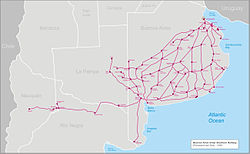Buenos Aires Great Southern Railway
| Buenos Aires Great Southern Railway | |||
|---|---|---|---|
 |
|||

Constitución station in 1885.
|
|||
| Overview | |||
| Native name | Ferrocarril del Sud | ||
| Type | Inter-city | ||
| Status | Defunct company; rail line active | ||
| Locale |
Buenos Aires La Pampa Rio Negro Neuquén |
||
| Termini |
Buenos Aires C. de Patagones Zapala |
||
| Operation | |||
| Opened | 1862 | ||
| Closed | 1948 | ||
| Technical | |||
| Line length | 8,149 km (5,064 mi) | ||
| Track gauge | 1,676 mm (5 ft 6 in) | ||
|
|||
The Buenos Aires Great Southern Railway (BAGS) (Spanish: Ferrocarril del Sud) was one of the Big Four broad gauge, 5 ft 6 in (1,676 mm), British-owned companies that built and operated railway networks in Argentina. The company was founded by Edward Lumb in 1862 and the first general manager was Edward Banfield after whom the Buenos Aires suburban station of Banfield was named, when it opened in 1873. After president Juan Perón nationalised the Argentine railway network in 1948 it became part of the state-owned company Ferrocarril General Roca.
The market of Plaza Constitución in Buenos Aires was attended by the carts coming from the South of the province that crossed the Riachuelo through the "Puente de Gálvez". Due to this transport was too costly, the products could not be carried on very long distances. In 1860, 7,416 carts with wool and leather had arrived to Constitución (each vehicle had a capacity of 25 packages 100 kg each).
About the passenger transport the situation was pretty similar. The carriages made three trips per month to Lobos, Cañuelas, 25 de Mayo, Saladillo and Dolores, two trips per month to Tandil and Lobería and just one to Bahía Blanca. The carriages were accompanied by "cuarteadores", that helped to cross rivers and streams. There also were intermediate stops such as "La Botica", a pulpería in Lomas de Zamora of Greater Buenos Aires.
...
Wikipedia

